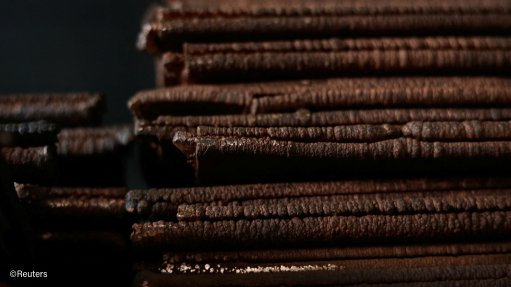Slave wreck artefacts set for next trans-Atlantic journey
This article has been supplied as a media statement and is not written by Creamer Media. It may be available only for a limited time on this website.
Over 220 years after it foundered just off the Clifton coast in Cape Town, the discovery of the shipwreck of the Portuguese slaver, São José Paquete de Africa was the first successful effort ever, to bring to light the archaeological vestiges of one of thousands of vessels that brought over ten million Africans in chains to the Americas. The submerged site of the São José and the artefacts recovered from this wreck are both unique and priceless.
These artefacts are set to depart on a further trans-Atlantic journey. They are destined for display as part of the Smithsonian National Museum of African American History and Culture’s (NMAAHC) inaugural exhibition entitled “Slavery and Freedom” when the museum opens its doors in Washington DC on 24 September 2016. It is apt that this opening coincides with South Africa’s celebration of Heritage Day.
On 13 July 2016, the South African Embassy in Washington DC will host a celebration of the international research partnership between Iziko Museums of South Africa (Iziko), the Smithsonian National Museum of African American History and Culture and George Washington University. These institutions are part of a broader global partnership, the Slave Wrecks Project that spearheaded the historic discovery of the São José wreck. The SWP has been investigating the impact of the slave trade on world history for nearly a decade and the on going documentation, retrieval and conservation of select artefacts.
“The São José slave shipwreck site reverberates with historical significance and represents an addition to our underwater heritage that has the potential to advance knowledge and understanding of slavery, not only at the Cape, but on a global level. The São José narrative, while linking with sites such as the Iziko Slave Lodge, where many enslaved Mozambicans were incarcerated, simultaneously opens up opportunities for links with sites of enslavement in Mozambique and Brazil.
The story of the Saõ José is more than an African story. It is a story that transcends time, space, place and identity. It is a global story of our inter-connectedness as a human race. It is a story of migration, and of untold human wrongs,” said Rooksana Omar, CEO, Iziko.
The São José artefacts significantly represent a narrative that intersects the story of slavery at the Cape with that of the enslavement of Mozambicans, and with the trans-Atlantic slave trade, particularly in relation to Portugal and Brazil. Remnants of shackles; four iron ballast - to weigh down the ship and its human cargo; a wooden pulley block, and a portion of ship’s timber, retrieved from the wreck site of the São José will be on loan to NMAAHC for a period of ten years. Thereafter, the objects will re-join the remainder of the Iziko collection. During the loan period, the majority of archaeologically documented artefacts from this site will remain in South Africa.
The recovered artefacts bear testimony to the tragic events of December 1794, which witnessed the São José break up and disappear under the turbulent Cape waters, just off the area now known as Clifton Beach, carrying 211 enslaved Mozambicans to a watery grave. The 200 enslaved Mozambicans rescued from the sinking slave ship were sold into slavery at the Cape.
Bringing the developing story of this one ship – and the stories of those who were enslaved on board – into the collective memory of people across the globe represents the collective effort by SWP researchers and scholars from Mozambique, South Africa, Portugal, Brazil, and the United States.
Iziko Maritime archaeologist and primary investigator of the Saõ José project, Jaco Boshoff noted: “This work demonstrates how we build global networks. That’s how we advance science, that’s how we generate new knowledge, and I think it is a model that we could develop to use elsewhere.”
In addition Lonnie G. Bunch, III, Founding Director of the National Museum of African American History and Culture remarked: “Perhaps the single greatest symbol of the transatlantic slave trade is the ships that carried millions of captive Africans across the Atlantic never to return.
The São José is all the more significant because it represents one of the earliest attempts to bring East Africans into the trans-Atlantic slave trade—a shift that played a major role in prolonging that tragic trade for decades. Locating, documenting, and preserving this cultural heritage through the São José has the potential to reshape our understandings of a part of history that has been considered unknowable.”
Comments
Press Office
Announcements
What's On
Subscribe to improve your user experience...
Option 1 (equivalent of R125 a month):
Receive a weekly copy of Creamer Media's Engineering News & Mining Weekly magazine
(print copy for those in South Africa and e-magazine for those outside of South Africa)
Receive daily email newsletters
Access to full search results
Access archive of magazine back copies
Access to Projects in Progress
Access to ONE Research Report of your choice in PDF format
Option 2 (equivalent of R375 a month):
All benefits from Option 1
PLUS
Access to Creamer Media's Research Channel Africa for ALL Research Reports, in PDF format, on various industrial and mining sectors
including Electricity; Water; Energy Transition; Hydrogen; Roads, Rail and Ports; Coal; Gold; Platinum; Battery Metals; etc.
Already a subscriber?
Forgotten your password?
Receive weekly copy of Creamer Media's Engineering News & Mining Weekly magazine (print copy for those in South Africa and e-magazine for those outside of South Africa)
➕
Recieve daily email newsletters
➕
Access to full search results
➕
Access archive of magazine back copies
➕
Access to Projects in Progress
➕
Access to ONE Research Report of your choice in PDF format
RESEARCH CHANNEL AFRICA
R4500 (equivalent of R375 a month)
SUBSCRIBEAll benefits from Option 1
➕
Access to Creamer Media's Research Channel Africa for ALL Research Reports on various industrial and mining sectors, in PDF format, including on:
Electricity
➕
Water
➕
Energy Transition
➕
Hydrogen
➕
Roads, Rail and Ports
➕
Coal
➕
Gold
➕
Platinum
➕
Battery Metals
➕
etc.
Receive all benefits from Option 1 or Option 2 delivered to numerous people at your company
➕
Multiple User names and Passwords for simultaneous log-ins
➕
Intranet integration access to all in your organisation


















